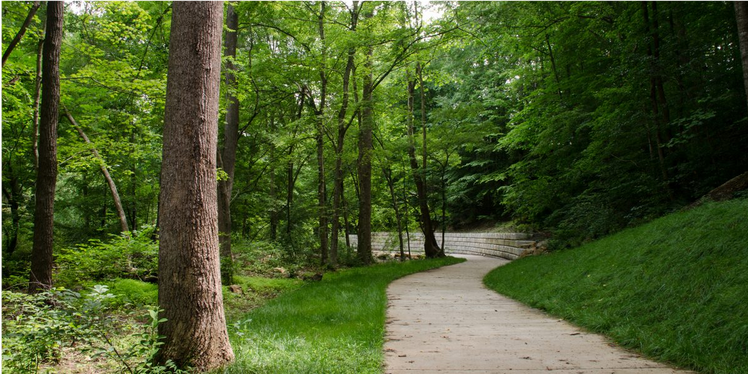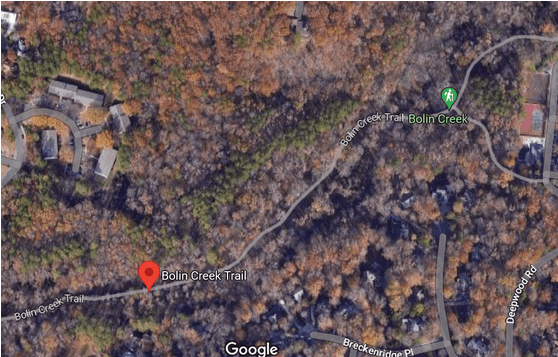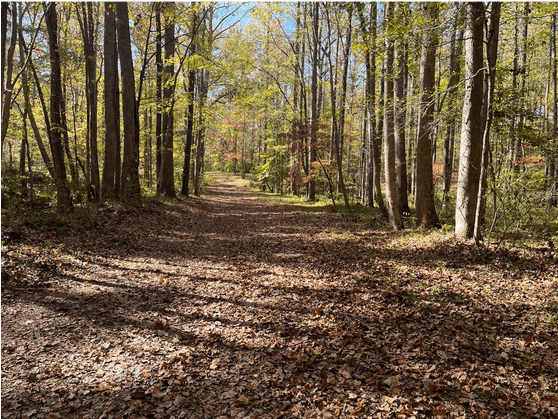A new petition has started circulating from Friends of Bolin Creek, the anti-greenway group that has stalled Carrboro’s efforts to build out a 10-foot paved path along an existing 30-foot-wide sewage easement along Bolin Creek.

A paved path already exists in Chapel Hill along Bolin Creek, and similar greenways exist in Hillsborough, Durham, Raleigh, Cary and hundreds of other places across the United States. Greenways have been used to improve stormwater, repair riparian zones, and create safe and accessible walking/biking/rolling paths for people of all ages and all mobility levels.
If I read the petition without knowing the backstory of Carrboro’s greenway, I might sign it. It’s scary! But this petition — the third this group has launched in the past 15 years — is also filled with misleading and factually inaccurate information.

Sign up for the Carrboro Linear Parks Project mailing list to get updates on building out Carrboro’s greenway network. Visit the Carrboro Linear Parks Project website for more information. There’s also a helpful FAQ with answers to many questions.
Update: We support the creekside alignment for the reasons detailed here.
We’re fact-checking it below. If you see the petition circulate on your neighborhood listserv or in your circles, please share this blog post.
And if you’d like to join our efforts to build out the greenway — again, along the existing sewage easement — please visit the Carrboro Linear Park Project and sign up for the mailing list.
Fact: Carrboro’s greenways have always had extensive public support, both in town-wide surveys and in discussions
Claim One: Carrboro Town Council is once again considering the divisive and controversial construction of a ten-foot wide concrete path from Estes Drive to Homestead Road along Bolin Creek despite deciding in 2009 to pause this greenway project due to extensive costs and minimal public support.
The controversy and divisiveness around this project have been entirely manufactured by Friends of Bolin Creek.
Some history: Funds for the Bolin Creek and Morgan Creek greenways were included in a sidewalk bond referendum approved by Carrboro voters in 2003. In 2007, the Carrboro Board of Alderman set up a town greenways commission to study and plan for greenways along Morgan and Bolin Creeks. Public input was solicited repeatedly throughout the project. There was large public support for this project.
By 2009, things were going well and the paved greenways were slated to be “finished by the end of the year….”barring unforeseen delays.”
Enter the unforeseen delay in the form of Friends of Bolin Creek, the anti-greenway group. A group of people led by former Chapel Hill Town Council Member Julie McClintock — then a Chapel Hill resident and one-time leader in the Chapel Hill Alliance for a Livable Town (CHALT), the Alliance of Neighborhoods, Estes Neighbors, Affordable Transit for All (which worked to block light rail), the Booker Creek Alliance, Save Bolin Creek, and Friends of Bolin Creek — worked to block the greenway. Among their claims was that we would lose our pileated woodpeckers and wildflowers if we paved a 10-foot wide sidewalk path through the existing, cleared 30-foot OWASA corridor.
We know:
- The birds and wildlife on Chapel Hill’s section of Bolin Creek have not been affected by the paved path in Chapel Hill (the eBird counts show lots of warblers and woodpeckers), and there is no evidence that the creek or water quality has deteriorated as a result.
- Bolin Creek has been impacted by decades of human activity. There are sewer manholes next to the creek, sewer pipes that carry wastewater across the creek, and the Bolin Forest HOA has built several play structures right up to the creek’s edge. Local landowner PH Craig clear-cut his large forested parcel bordering the creek. The trail along the creek is severely braided in some areas where trail users are avoiding puddles by going around them, widening the trail and encroaching further into the forest. The video below shows its poor condition. A managed greenway would do more to preserve Bolin Creek than the current easement.
One of the many great things about Carrboro is that they survey their residents about what they want to see in town. And in the 2021 survey, where they surveyed over 500 households to reach a 95% level of confidence in the responses, you’ll find this in the Executive Summary:
Based on the sum of their top two choices, the transportation services that residents thought were most important were: 1) ease of walking in Carrboro, 2) availability of greenways/multi-use paths, and 3) ease of driving in Carrboro.”
People throughout our town want safe, accessible ways to get around.
Fact: The mountain biking trails will remain. A 10-foot wide trail in almost 1,000 acres of forest will keep people on a path, which can help wildlife and stream restoration.
Claim 2: The Council is revisiting the original 2009 plan, now called Bolin Creek Trail Phases 3 & 4 – an estimated five-to-ten year project requiring extensive grading, blasting, clearing and cutting through the heart of a large portion of Horace William’s forest gifted to UNC. When joined with other tracts, this is a 429-acre sanctuary for endangered species and migratory birds, hikers, nature lovers and mountain bikers.
The mountain biking trails will not go anywhere. Birds are routinely spotted along Bolin Creek in Chapel Hill.
It helps to go back to the original plan. The Bolin Creek conceptual plan was written in 2009. You can read it here.
The Carolina North Forest, which contains Bolin Creek, is 973 acres. Approximately three of those acres along the creek would be paved, and it’s a section that is largely tree-free because of the existing sewer easement. We show an abstract representation of these impacts below:

Let’s look at the existing Bolin Creek Greenway in Chapel Hill. As you can see, the greenway exists (it is the marked trail below), but wide corridors of forest remain on both sides of the path. That’s great, because “the width of the forested corridor adjacent to the trail is way more important to birds and other wildlife than the characteristics of the trail itself.” You can see the 110 bird species spotted along this section of the paved Bolin Creek Trail in Chapel Hill. People of all ages and mobility levels use this trail on a daily basis. There are people in strollers, wheelchairs and walkers able to access this trail.

We can see this also in Hillsborough. If you’ve ever walked along the Riverwalk, it’s a lovely, serene greenway along the Eno River. You can see the 117 species of birds spotted along this trail on eBird. And the forest has not changed — it still remains on either side of the accessible paved path. From the air, you can see the width of the greenway compared to the width of the forest. People of all ages and mobility levels use this trail on a daily basis.
We also take issue with the claim that it would take five to ten years. The only reason it has taken 15 years so far is because of FOBC’s obstruction.
Fact: This area is already heavily traversed, by both people and sewage department equipment. It’s a sewage easement corridor.
Claim 3: This is not a clump of trees to be traversed by commuters, but if conserved a symbol of Carrboro’s steadfast dedication to environmental preservation.
The path is along a sewage easement, much like the path in Chapel Hill.
And so for many decades now we have had this wide, tree-less sewer easement running along the creek. This is so the heavy equipment that utilities needs to occasionally bring into the forest can get there.
It looks like this:

To the extent that anyone would call this “deforestation”, that activity already occurred when we developed the northern end of Carrboro. Single family homes are spread throughout our town and each of them required some trees to come down.
Fact: It will not remove many trees, because it’s on a sewage easement. Chapel Hill’s paved path has not changed the water quality of Bolin Creek, but has added immeasurable benefits for people to have a safe and accessible path.
Claim 4: This concrete structure would remove many trees, increase pollution of Bolin Creek, already listed by the EPA as an impaired waterway, and would intensify flooding for neighbors living downstream. Additionally, it would violate Jordan Lake rules that allow multi-use paths within riparian zones ONLY if no practical alternatives exist.
Would some trees have to come down to build a greenway along this path?
The trail alignment will require some tree removal. But keep in mind that a mature tree offsets about 22kg of CO2 year. Meanwhile, building a greenway that would potentially eliminate thousands of car trips a year from people dropping their kids off at school or traveling to the library on a bike would have a giant impact. (0.5 ton per year if you reduce car use by just one day per week.)
This is what climate action looks like at the local level.
The Bolin Creek Greenway in Chapel Hill has not changed in terms of water quality. That’s because our towns are full of asphalt roads and parking lots. We live in an urban environment and Bolin Creek is surrounded by homes with driveways and roads. The impacts are already occurring and will continue to occur in the future. The responsible thing for the town to do is to “accommodate human use and work to restore landscape degradation that has occurred throughout the decades.”
In addition, the impact Jordan Lake rules have been addressed many times. Here’s a 2009 letter from Chuck Flink — who has designed over 250 greenways — addressing that.
Fact: Communities across NC have built greenways and there are many sources of funding to pay for them.
Claim five: If the environmental reasons weren’t enough, the cost of this project is unknown. So far there has been no information or discussion of the price that taxpayers, homeowners and HOAs will pay for this project such as potential long-term maintenance requirements or costs that could be passed directly to all taxpayers by way of increased property taxes, HOA fees and higher rent payments.
There are many ways to fund a greenway – as we’ve done with the parts of the greenway that have been completed, and as Chapel Hill, Durham, Raleigh, Cary, Charlotte, and Asheville have done with their greenways.
We can also examine what the costs are to have the status quo: long lines of people waiting outside schools for kids, people not having an accessible way to enter nature.
Fact: Some of these purported trails will never exist in our lifetime. Others are really, really unsafe for even experienced bikers. (And that doesn’t include walkers, the primary users of the Bolin Creek trail in Chapel Hill.)
Claim 6: UNC had planned a bikeway connecting Estes Drive to Homestead Road via Seawell School Road that will be much less environmentally destructive, less costly for Carrboro taxpayers, and doesn’t cut through the middle of the forest. This project could be funded with Federal dollars at a fraction of the cost of the creekside route. Additionally, when UNC shuts down its coal plant, repurposing the rail tracks to a bikeway presents another alternate route.
Some of these routes are vaporware and not likely to take place in our lifetime. Others are really, really unsafe for kids. We outline them here: Bolin Creek Greenway Alternative Bike Map: “Not something I’d ever let my kids ride on”. And we chuckle at the claim that an alternative could be funded with “Federal dollars” at a fraction of the cost.
We can conserve the creek and provide many additional benefits through a small paved path — which will help transport kids to school, connect communities across Carrboro, and help restore the stream.
Sign below: Urge the Carrboro Town Council to conserve, not pave the Bolin Creek trail. Keep Bolin Wild!!!
We, the undersigned:
– Request the Town Council of Carrboro protect and preserve our forest and fight climate change by providing a natural undisturbed habitat for a diverse, healthy ecosystem for all humans, animals and plants;
– Oppose implementation of a ten-foot wide, concrete transportation route from Estes Drive to Homestead Road along Bolin Creek Phases 3 and 4;
– Support alternative routes outside the riparian zone such as the off-road bikeway along Seawell Road.
The habitats of animals and the stream area are already being disturbed by people walking and biking along the creek. This is one of the key benefits to constructing the Bolin Creek Greenway in Carrboro: providing a defined paved surface along the heavily used easement will open up possibilities to reclaim and restore natural areas around the creek as part of the same project. These strategies are clearly outlined in the town’s 2009 Bolin Creek Greenway Concept Master Plan. In some areas, like where I was on my walk, the plan recommends a raised boardwalk or moving the trail further upland so that the damaged area near the creek can be regenerated.